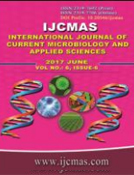


 National Academy of Agricultural Sciences (NAAS)
National Academy of Agricultural Sciences (NAAS)

|
PRINT ISSN : 2319-7692
Online ISSN : 2319-7706 Issues : 12 per year Publisher : Excellent Publishers Email : editorijcmas@gmail.com / submit@ijcmas.com Editor-in-chief: Dr.M.Prakash Index Copernicus ICV 2018: 95.39 NAAS RATING 2020: 5.38 |
Cassava (Manihot esculenta Crantz) is among the main food crops of Togo. In the country’s traditional agriculture, a great diversity a varieties exist and need to be preserved. Moreover, the production constraints that can be solved through breeding of novel varieties and the farmers’ varietal preference criteria are not yet well documented. To fill these gaps of knowledge a survey was conducted in 40 villages distributed throughout the country using participatory approach (individual survey and group discussion with questionnaire). The first 5 most important constraints at national level were: the attacks of insects, low marketable value of cassava roots, leaves and stem diseases (mainly viruses and bacterial diseases), and root rots. The most important varieties preference criteria were high productivity, early maturity, the good poundability, resistance to diseases, good quality of gari and good in ground post maturity conservation. The number of varieties maintained per household varies from 1 to 8 with 2 in average. No seed is used as planting material. The crop is propagated only by stem cuttings and the farmers’ knowledge on the floral biology, diseases and their propagation, the use of botanical seeds to generate plantlet, the contribution of the reproductive biology to the enhancement of the existing diversity and to the development of new cultivars is very low. No strategy is put in place for the preservation of the diversity and its sustainable use. The study recommends intensive education and sensitization of the farmers as well as their organization for cassava biodiversity conservation in Togo.
 |
 |
 |
 |
 |